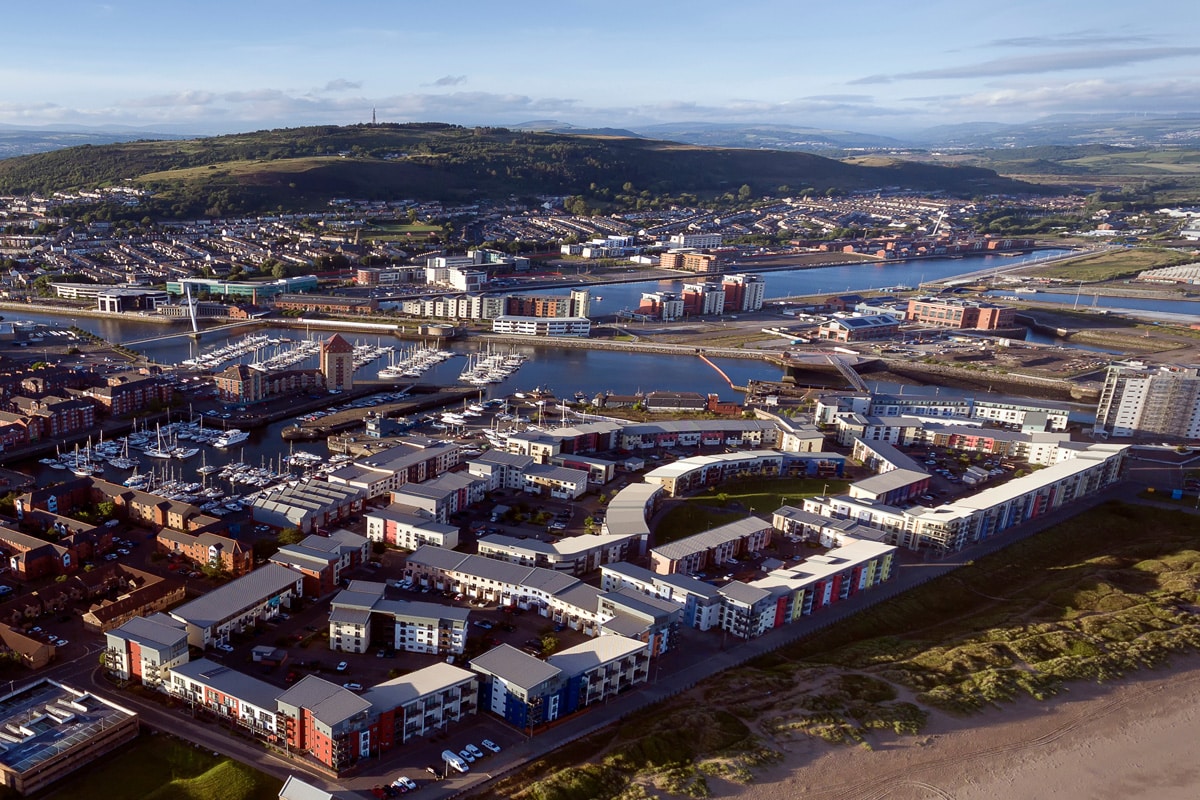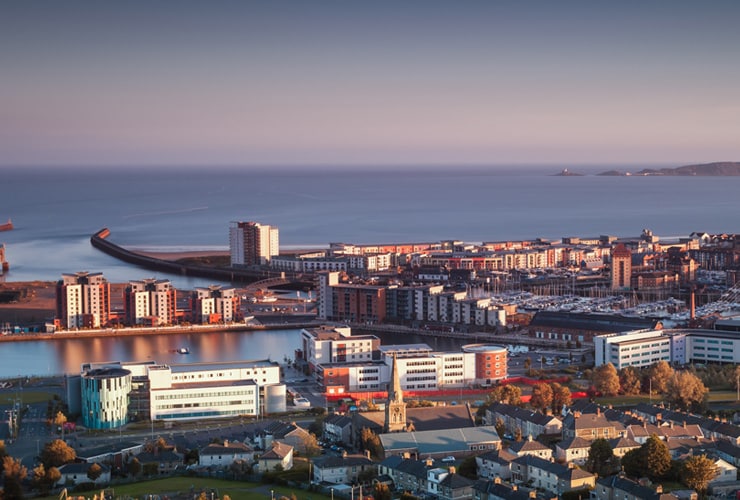Areas of Swansea: Property Investment Buy-to-Let Hotspots
A ‘sleeping giant’ might be a very good way to describe Swansea as a property investment opportunity! Swansea is a city that many property investors overlook, probably because they don’t know much about it. But Swansea has some of the cheapest property of any UK city, some ambitious plans for the future and an economy that’s poised for greatness. Here we’ll look at what this sleeping giant has to offer property investors.
Why Invest in Swansea?
Swansea (or Abertawe in Welsh) is Wales’ second-largest city. The City and County of Swansea area, as it’s known, has a population of around 237,800 (mid-year estimate 2021) – that’s 8% of the whole population of Wales.
Swansea was originally a port and heavy industrial city but these traditional industries declined in the 80s. Today the main Swansea industries are mostly in the service sector such as professional and financial services, technology, communications, life sciences, marine industries, creative industries, health, education and public administration. One of the biggest single employers here is the Driver and Vehicle Licensing Agency which employs around 6,000 people.
Regeneration is always good for property investment and in recent years Swansea has regenerated itself as a new, modern city. The Maritime Quarter and Swansea Marina have given Swansea a smart waterfront area that people want to live in, work in and visit.
Swansea has a lot of regeneration projects underway as well. These include the Copr Bay development, which is seeing 1 billion being invested across the city and Swansea Central North, which is a development including offices, leisure and residential which will link the city centre to the Copr Bay arena and waterfront.
Although plans for a tidal lagoon at Swansea Bay were dropped when the developer lost a planning appeal, the £1.7bn Blue Eden project looks set to go ahead. This will see a 9.5km long breakwater with floating solar panels and will be a breakthrough in renewable energy as well as creating a lot of jobs.
Another thing most property investors don’t know about Swansea is that it is growing fast as a student city – all good news for student property investors. This report says that in 2021 students contributed £869.26m to Swansea's economy.
Swansea University in 2023 has around 20,415 students with campuses at Singleton Park and the Bay Campus at Jersey Marine. The University of Wales Trinity Saint David has around 10,000 students and a new SA1 Waterfront campus. Popular areas for Swansea student houses include Brynmill, Uplands, Sketty and Mount Pleasant.
Amenities and Culture
Swansea boasts many amenities, including shopping centres, bars, restaurants and cultural attractions. The city is also a great base for exploring the surrounding Welsh mountains and countryside.
The Quadrant Centre and Oxford Street are the main hubs for shopping, with all the usual high street stores. For foodies, Swansea has a reputation for its ice cream, with the nationally acclaimed Joe's Ice Cream a must-visit. The city also has a strong cafe culture, with many Italian-inspired coffee spots.
Speaking of culture, Swansea has several notable museums and galleries, including the Dylan Thomas Centre, dedicated to the famous Swansea-born poet. The Glynn Vivian Art Gallery exhibits local artists' paintings and frequently hosts national and international exhibitions. The National Waterfront Museum, housed in an iconic building clad in Welsh slate, explores the history of the Industrial Revolution.
Theatregoers will be spoilt for choice in Swansea, with several venues hosting a variety of performances. These include the Grand Theatre, the Taliesin Arts Centre and the Dylan Thomas Theatre.
Swansea boasts several dedicated music venues. The Bunkhouse Bar is a popular spot. The Vault Live Music Venue, located within the No Sign Bar, is another hub of the city's music scene, found in the renovated vaults of a 1400s wine cellar. Original music is a focus here, and the venue is known for supporting local talent. But of course, there are bigger music venues too, including Swansea Arena and Hanger 18.
If you fancy a day at the beach, Swansea has a five-mile stretch of sandy coastline, which is just a five-minute walk from the city centre. Gower Peninsula, to the west of the city, has some of the most impressive beaches, including the award-winning Oxwich Bay. Swansea also has several scenic parks, including Singleton Park, Clyne Gardens and Country Park, and Cwmdonkin Park – a favourite of Dylan Thomas.
For accommodation, visitors can choose from a range of options, including luxury hotels like the five-star Morgan's Hotel, or more affordable guest houses and B&Bs.
Swansea also has a lively sports scene. The city is home to Swansea City AFC, also known as the Swans. The football club has a rich history, including a period of rapid promotion in the 1970s and 1980s and something of a subsequent decline. Today, they play in the Championship League. Their home games are held at the Swansea Stadium.
For rugby fans, Swansea is home to two major teams: the Ospreys, who play in the Celtic League; and Swansea RFC, semi-professionals who play in the Welsh Premier League.

Property Values
House prices in Swansea have demonstrated a recent downward trend, with several sources reporting a decrease in average property prices over the last year. The average price of a property in Swansea is now estimated to be £180,000 as of March 6, 2024, although prices can be much higher for more desirable properties.
This downward trend is also reflected in the average price per square foot in the area, which stands at £192.59 — compared to an average of £333.26 for England and Wales, as a whole.
As of March 2024, the most affordable properties in Swansea are found in the SA13 3 postcode, where the average price is £101,000. In contrast, the SA3 1 postcode area is the most expensive, with an average price of £438,000.
The majority of properties that have sold in Swansea over the past year were terraced properties, fetching an average of £158,395. Flats are also popular, with an average sold price of £94,446.
Sales volumes have also decreased by 34.1% in the past year. According to one source, this mini-boom following the loosening of lockdown restrictions created a surge in demand, which has now subsided.
However, one source estimates that the average listing price in Swansea has increased by 3.01% over the past 6 months, up to £288,429.
Rental Demand
According to RWinvest, Swansea's rental market offers an average rental income of £844 per month or a 5.27% yield. In 2019, four Swansea postcodes were featured in the top 10 for the best rental yields in Wales. These included SA1, SA31, SA5 and SA6.
The city's rental market is largely driven by students attending Swansea's fast-developing university. Landlords looking to tap into this market should consider properties near the university.
Properties in Swansea's city centre and surrounding areas, including SA1 and SA2, are also popular among young professionals.
Some of the most lucrative areas for landlords in Swansea include The Mumbles, Derwen Fawr, and Uplands. Alternatively, properties in areas with high concentrations of HMOs, such as Brynmill and Mount Pleasant, could be good options for high rental yields.
However, all landlords in Wales must register with Rent Smart Wales, which also processes licences for HMOs. Landlords who fail to comply with the scheme may face penalties.
Average Property Price (Price Paid) by Postcode Area
Last updated: March 2024
| Postcode District | Average Property Price |
|---|---|
| SA1 | £193,535 |
| SA2 | £260,020 |
| SA3 | £294,424 |
| SA4 | £249,583 |
| SA5 | £153,529 |
| SA6 | £257,482 |
| SA7 | £216,088 |
| SA8 | £211,827 |
| SA18 | £185,286 |
Landlord Licensing
All landlords in Swansea are required by law to register with Rent Smart Wales. The scheme processes landlord registrations and grants licences for letting and management activities within the private rented sector. Landlords who manage their properties themselves must also apply for a licence, undergo training and abide by the scheme's code of practice.
There are also several licensing schemes in place relating to HMOs. As is the case everywhere in England and Wales, the Housing Act 2004 enforces a mandatory licensing scheme for certain HMOs.
In Swansea, the local authority has an Additional Licensing Scheme for HMOs in certain wards, including the Castle, Uplands, Waterfront and St Thomas wards. These wards require all HMOs, irrespective of their size, to be licensed. The licence applies to the property, not the landlord, and failure to obtain one is a criminal offence resulting in a fine of up to £20,000.
Article 4 Directions are in place across the city, relating to specific properties, and removing permitted development rights for changes which may undermine the special historic character of conservation areas.

Property Investment in Swansea
Here are a few pointers on the different areas of Swansea for property investors.
City Centre and Maritime Quarter
Population: 12,000
Average House Price: £188,650
Swansea city centre is popular for city living and in particular, is becoming more and more popular for student accommodation. Most properties are flats in older or newly built blocks with some townhouses. But the real draw for Swansea city living is the Maritime Quarter which offers a range of properties from affordable homes to swish penthouse apartments. It offers landlords lots of buy-to-let opportunities.
Yields in SA1 are up to about 6%.
South and West Swansea
Population: 65,500
Average House Price: £177,000-£430,000
The districts south and west of the city tend to be Swansea’s favourite residential areas and are ever popular with both buyers and buy to let investors. These areas offer good access both to Swansea city centre and the Gower.
Prices tend to be at the Swansea average or above with prices normally rising with distance from the city. Closer areas like Sketty, Uplands and Brynmill offer lots of Victorian and Edwardian properties offering good value. Further out places like Oystermouth, Bishopston and Mumbles tend to be more upmarket.
On average yields in SA2 are around 4%.
North Swansea
Population: 86,000
Average House Price: £125,000-£150,00
North Swansea benefits from close proximity to the M4 and a number of business parks providing employment. Areas in north Swansea include Fforestfach, Llandore, Morfa, Bon-y-Maen, Mynydd-Bach, Morriston and the separate town of Gorseinon. It is generally a mid-lower priced part of the city. Property types include older terraces and a number of large housing estates offering good value to buy to let investments.
Yields are around this area, in SA5, SA6 and SA7, are about 4%-5.2%.
Gower Peninsula
Population: 7,200
Average House Price: £250,000-£500,000
Gower is a prime residential area for affluent Swansea commuters, as well as a tourist and visitor hotspot. That makes it the most expensive area with prices well above the Swansea average, although still much lower than much of the UK.
Yields are around 3% across the SA3 area, although a holiday letting or Airbnb type rental could probably return much more.
Other Areas To Consider
As well as the city itself, some of the areas around Swansea offer good value property and easy access into the city. Here are some other areas to consider:
Llanelli
Population: 49,500
Average House Price: £155,800
The town of Llanelli is a Swansea commuter spot but has local employment of its own. Swansea is 20 minutes away by road and 15 minutes by train.
Yields are around 3%-4% in SA14 and SA15.
Neath
Population: 19,200
Average House Price: £162,000
The historic small town of Neath is around 20 minutes by road and as little as 10 minutes by train from Swansea.
Yields are around 4% in SA11.
Port Talbot
Population: 35,600
Average House Price: £146,000
The industrial town of Port Talbot is 17 minutes by train or 15-25 minutes by road from Swansea. Its main employer is the huge Tata Port Talbot Steelworks. Port Talbot is a cheap property hotspot.
Yields are around 4% across SA12 and SA13.
